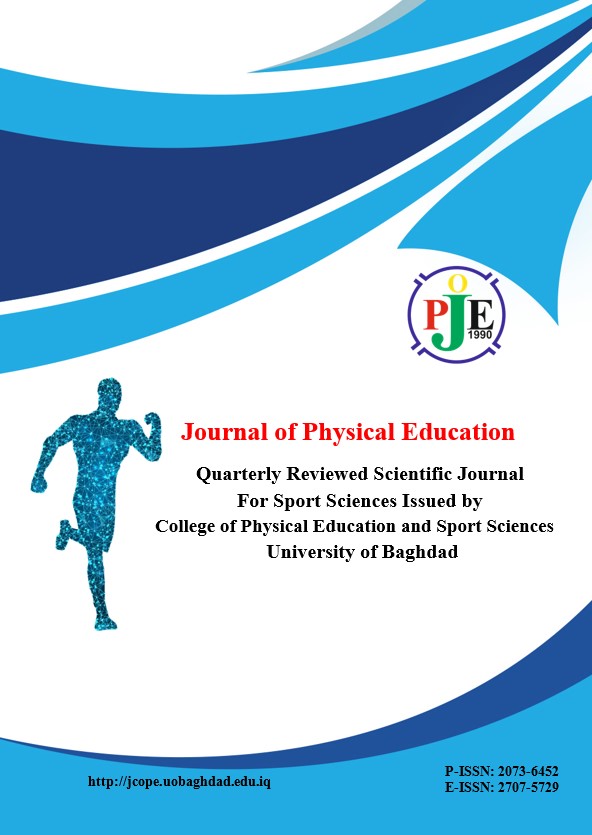تدريب السرعة وفق القدرة – الشغل بالاعتماد على فترات الراحة لتحسين الطاقة الحيوية وانعكاسها على الطاقة الحركية وإنجاز 100م
الكلمات المفتاحية:
الطاقة الحيوية، الطاقة الحركيةالملخص
تكمن أهمية البحث في التركيز على اعادة بناء نظام الطاقة الحيوية التي يتميز بها رياضيو القطر العراقي في سباق 100 متر من خلال فترات استعادة الشفاء وانعكاسها على الطاقة الحركية اثناء التدريبات الخاصة بالسرعة , ولم تتم دراسة مدى تأثير هذه الأساليب التدريبية مع رفع مستوى الطاقة الحيوية لهذه المسابقة (الفوسفاجينية) وتأثيرها في الطاقة الحركية للرياضي عند إنجاز شغل بدني في عضلاته لقطع المسافة بأعلى كفاءة واقل زمن ممكن. إذ أن الرياضي الذي يبذل طاقة حركية عالية يجب ان يكون هناك ما يقابلها من إنتاج عالٍ للطاقة الحيوية ويمكن أن تكون العلاقة متبادلة بين هاتين الطاقتين اللذان يعدان مقياساً مهما لتقويم نوعية التدريبات التي يمارسها الرياضي لتطوير الإنجازات في هذه الالعاب.فضلا عن ذلك لم يستخدم احد قانوني القدرة والشغل في تحديد شدة التدريب بالاركاض القصيرة واعتماد فترات الراحة اللازمة لاعادة نظام الطاقة الحيوي المسيطر عليها. اذ ان استخدام قانون الشغل وقانون القدرة في تحديد شدة التدريب، يعتمد على شغل العضلات الذي ينجزه جسم الرياضي عند بذل قوة بسرعة معينة , لذا فالشدة هنا ترتبط بسرعة الحركة وحجم القوة المنتجة فيما لو اقترنت هذه الشدة بامتزاج القوة والسرعة، على اساس أن الشغل = الطاقة الحركية , وهذا القانون لم يستخدم سابقا في تحديد شدة التدريب للاركاض القصيرة وهذا بحقيقته يعد توجها جديد في رياضة المستويات العليا. وهدف البحث الى:التعرف على الشغل العضلي (الطاقة الحركية ) عند عدائي العراق بمراحل مختلفة من السباق .وكذلكالتعرف على تأثير المنهاج التدريبي بالاعتماد على فترات الراحة في تطوير الطاقة الحيوية وانعكاسها في الطاقة الحركية لعينة البحث.من خلال قانون القدرة والشغل.اما فروض البحث تكمن في ان هناك فروق معنوية في مؤشرات الطاقة الحركية باستخدام فترات راحة مناسبة لعينة البحث لمراحل مختلفة من السباق بين الاختبارات القبلية و البعدية . وكذلك هناك فروق معنوية في مؤشرات السرعة الخاصة والانجاز بين الاختبارات القبلية والبعدية لعينة البحث .تم استخدام منهج البحث التجريبي تم اختيار العينة بالطريقة العمدية المتمثلة بعدائي المنتخب العراقي الشباب في سباق 100 مترالبالغ عددهم ( 9 ) لاعبين وتم قياس متغيرات الطول ، الكتلة ، العمر ، العمر التدريبي ، الإنجاز في مسابقة 100 متر وقد استخدم الباحثون تدريب السرعة المطلقة. وتدريب سرعة السباق الخاصة. واستخدموا قانون الشدة (القدرة) = 0.5 ك( م2/ن3) لتحديد شدة التدريب وتوصل الباحثون الى الاستتاجات التالية1-تطور قابلية عينة البحث خلال مرحلة التعجيل 30 مترو50 متر 2-ظهر تحسن في معدل السرعة القصوى والطاقة الحركية لها والذي تحقق من خلال اختبار 70 متراً 3-هناك تطور في نتائج اختبار 760 متراً 4-أن الاستمرار في تطبيق المنهاج التدريبي حقق تكيفاً بدنيا وفسيولوجيا جيدا مما أدى الى تطور إنجاز 100 متراً لأفراد عينة البحث






